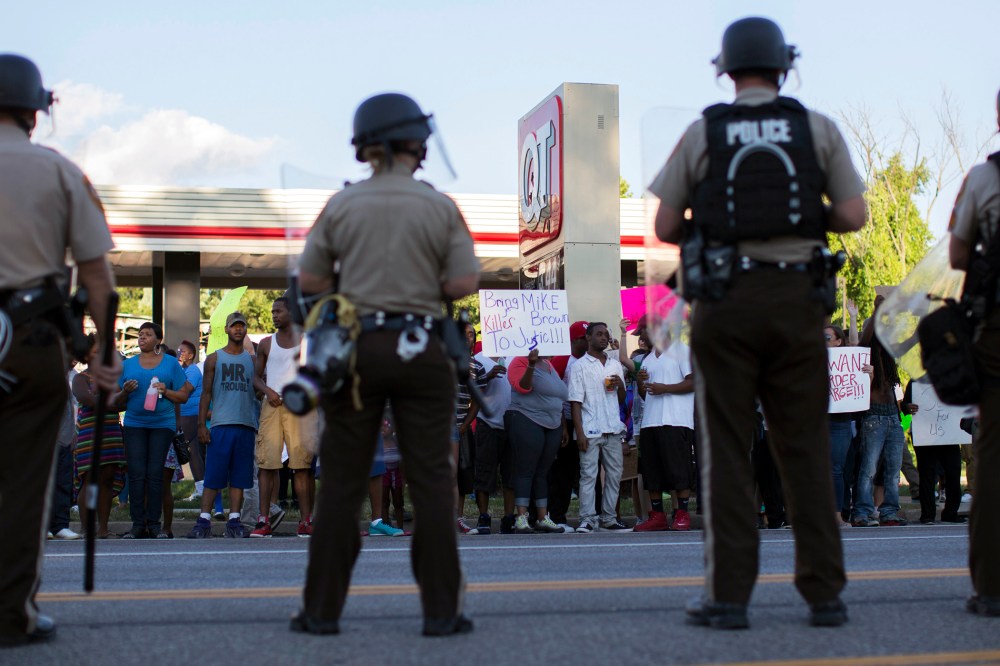Amid violent clashes between Ferguson, Missouri police and protesters angry over the shooting of a young unarmed black man Saturday, attention has focused on the glaring lack of diversity in the city’s police force.
But that problem is only a symptom of a larger one: Though two in three Ferguson residents are black, the city government is almost entirely white.
Local African-American leaders say that’s because, for a variety of reasons, blacks across the region simply haven’t participated in city elections. Until that changes, they add, Ferguson’s racial tensions aren’t likely to get better.
“We warned people about these kinds of things,” said John Gaskin of the Missouri NAACP. “Who hires the police officers? The police chief. Who hires the police chief? The mayor. Who hires the mayor? Who elects the council folks?”
Though whites make up just 29% of the city’s residents, five of Ferguson’s six city council members are white, as is Mayor James Knowles. And six of the local school board’s seven members are white.
Relations between ordinary blacks and whites in Ferguson — a city of 21,000 that’s part of St. Louis’s northern suburbs — are said to be relatively good. But, like the police force, the city government has come under fire during the current crisis for what many see as a lack of sensitivity to minority concerns.
%22Though%20two%20in%20three%20Ferguson%20residents%20are%20black%2C%20the%20city%20government%20is%20almost%20entirely%20white.%22′
A statement issued Tuesday by the mayor and city council thanked the St. Louis Police Department for its assistance and asked protesters to assemble “only during daylight hours and in an organized and peaceful manner.” Given the police’s aggressive show of force in recent days, including the use of military weaponry, tear gas and rubber bullets, the statement struck some as tone deaf at best.
And in an interview with msnbc Thursday, Knowles appeared to attribute the tensions between police and residents to low rates of homeownership.
St. Louis County Prosecuting Attorney Bob McCulloch also has been criticized for what many in the African-American community see as the slow pace of the investigation into Brown’s shooting. In April, McCulloch, who is white, defeated an African-American challenger, Leslie Broadnax, in the Democratic primary.
Black political leaders in the area say it’s not surprising that Ferguson’s government isn’t responsive to their community’s concerns, because blacks across St. Louis County simply haven’t turned out to vote in large numbers, or run candidates for office.
No one collects data on turnout by race in municipal elections. But the overall turnout numbers for Ferguson’s mayoral and city council election are discouraging. This year, just 12.3% of eligible voters cast a ballot, according to numbers provided by the county. In 2013 and 2012, those figures were even lower: 11.7% and 8.9% respectively. As a rule, the lower the turnout, the more the electorate skews white and conservative.
“I think there is a huge distrust in the system,” said Broadnax, a Ferguson native. Many blacks think: “Well it’s not going to matter anyway, so my one vote doesn’t count,” she said. “Well, if you get an entire community to individually feel that way, collectively we’ve already lost.”
Ferguson’s election system may also be a factor. For council elections, the city has three districts, or wards, and each ward elects two members each. That means it’s edging toward an “at-large” voting system, in which there are no districts at all, and all candidates face the whole electorate. Numerous jurisdictions around the country have used such systems to reduce minority representation, since it makes it harder for numerical minorities to elect their preferred candidates.
Then there’s the school board. Ferguson shares a board with neighboring Florissant, which is mostly white. And the district uses an at-large system to elect its seven members. The result: Until earlier this year, the board had no black members.











